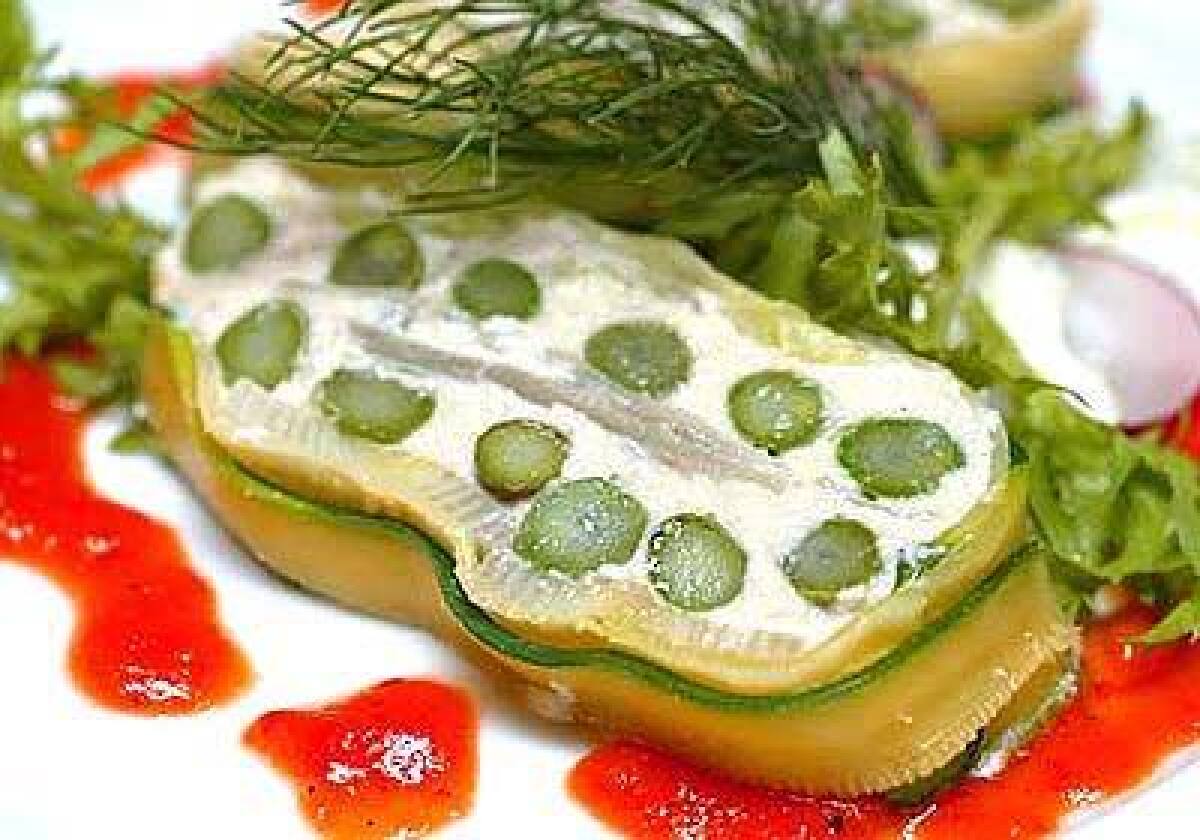Three gorgeous mosaics

- Share via
Eating out, I’m the kind of diner who rarely makes it past the appetizer section of a menu. I’m always torn between two or more wonderful-sounding small plates, so I end up ordering both and having one for my entree. Even in the best restaurants, it seems first courses are really where chefs strut their stuff.
Of course, loving the idea doesn’t mean I can duplicate the effect. I’m a weekend cook, intermittently enthusiastic, woefully unskilled and easily distracted. Anything requiring much in the way of technique or concentration is out of my league. But I aspire to be elegant.
Vegetable terrines — spectacular molded layers of the best the season has to offer — are among the prettiest dishes in the chef’s appetizer repertoire. As it turns out, although they’re a bit labor-intensive, they can become a part of my repertoire too. That’s because they require more patience than skill to create, and the work is divided into stages. They’re designed to be made ahead, and that’s one of my requirements for dishes I might serve when entertaining.
If, like a certain friend of mine, you subscribe to the theory of home entertaining in which you lavish attention on a flashy first course and an amazing finale (the idea is that no one remembers the middle anyway), you’ll find that a vegetable terrine makes a knock-’em-dead beginning. It also makes a terrific light vegetarian main course — just slice it a little thicker. Precede it with an easy soup or salad, and follow it with cheese, maybe some fresh fruit or a dessert you’ve picked up from your favorite bakery. Either way, there’s something really satisfying about putting together a terrine, then unmolding it, slicing it and seeing the beautiful mosaic inside. Terrines (the molds themselves) with removable sides make it easier to remove terrines (the dishes). You can find them at Surfas in Culver City. Lightly oiling the molds is also helpful. To serve, slice with an electric knife for smooth, uniform slices.
Chaya Brasserie is adding chef-owner Shigefumi Tachibe’s green terrine to the spring menu next week. This gorgeous dish pairs organic vegetables with cashew “cheese” — a spinoff of a popular ingredient in the arsenal of raw-foodists (here the cashews are blanched). Layers of varying shades of pale to deep green — fennel, leeks, artichoke hearts and asparagus spears — are set off by cream-colored layers of the nut cheese and surrounded by a casing of delicately thin zucchini slices. The bright, distinctive flavor of each vegetable comes through, and the cashew cheese is a rich and savory partner.
“At first I tried it with only vegetables, but it was a bit bland,” says Tachibe, “so we tried it with the cashew cheese, and it was very, very good.”
Traditionally, both meat and fish terrines were bound with aspic jelly (made from stock rich in gelatin or shortcut stock enriched with gelatin), and vegetable terrines were mousses.
“They weren’t done in the form we do now,” says chef Sam Marvin of Le Dôme. “Never with whole vegetables or cheese.” Like Tachibe’s green terrine, Marvin’s very modern ratatouille terrine is made without gelatin.
“It preserves the integrity of the vegetables,” says Marvin. “And it’s easy.”
Tachibe explains that summer vegetables, particularly tomatoes, cucumbers and zucchini, are rich in pectin, the natural gelatin-like substance. If the vegetables are blanched and not put in ice water, they will continue to release pectin and, if pressed into a mold, will bind together. The cashew cheese — or goat cheese, in the Le Dôme terrine — also acts as a binding element.
At Chaya Brasserie, slices of the terrine are drizzled with a tomato and red pepper coulis and garnished with a micro salad. Tachibe suggests that home cooks experiment with other vegetable sauces. Purée any extra vegetables not used in the terrine or whatever’s abundant in your garden and add a little olive oil and balsamic vinegar or some lemon dressing.
At Le Dôme, Marvin serves several terrines, including a leek terrine to accompany a fish entree. His ratatouille terrine — eggplant, zucchini, roasted red pepper and goat cheese — is part of a vegetarian main course special that is composed of several dishes.
“When you’re doing four elements on one plate, you have to simplify some of them,” he notes. “The terrine is nice because I can make it ahead.”
The corollary for the home cook is, of course, that trying to get several dishes to come out of the kitchen in proper sequence for a dinner party is like trying to get triplets into car seats by yourself. It helps to have one buckled in already.
Chef Massimiliano Blasone of Valentino created the caprese terrine. Paper-thin slices of tomato show as a pale and translucent red when layered above fresh buffalo mozzarella (though you can substitute any good, very fresh mozzarella) and basil. Whether viewed whole, from the side, or sliced to reveal red, white and green strata bound with a very light fresh tomato-water aspic (this one does use gelatin), the terrine has a strikingly contemporary look, vivid and summery. This is not your grandma’s tomato aspic.
The Valentino terrine must be started the day before, but what needs to be done is a perfect Friday night chore: You just chop tomatoes, wrap them in cheesecloth and hang them over a bowl. Even I can do that between arriving home from work and having a nightcap.
More to Read
Sign up for The Wild
We’ll help you find the best places to hike, bike and run, as well as the perfect silent spots for meditation and yoga.
You may occasionally receive promotional content from the Los Angeles Times.







